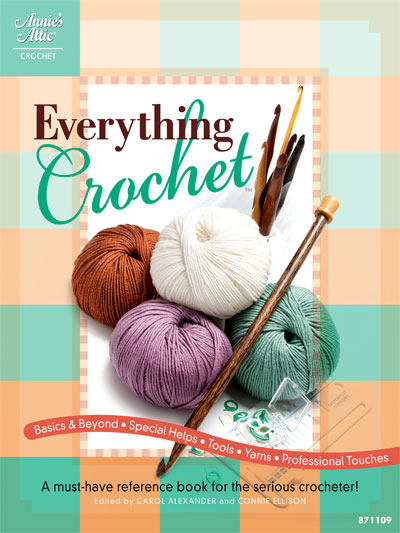This post includes affiliate links.
Today I’m reviewing Everything Crochet: A Must-Have Reference Book for the Serious Crocheter!, edited by Carol Alexander and Connie Ellison, a new crochet guide (with the subheading “A must-have reference for the serious crocheter!) published by DRG as an Annie’s Attic book.
Everything Crochet is a book book I would recommend to one of my beginner crochet students as s/he builds a reference library to help improve and expand her/his own crochet skills. It provides an in depth review of some of the great mysteries of crochet that most of us learn over time through trial and error and an introduction to many of the lesser known crochet techniques. The book aims to bring you from beginner through crochet professional as a detailed reference book for crochet. In the note from the editors, Carol Alexander and Connie Ellison announce, “At last, here is that one, must-have guidebook that will become a much-used and treasured staple in any crocheter’s library.” I’m not sure any book can live up to the standard of being the one book that every crocheter will need, but this one definitely covers a lot of areas usually ignored in other crochet guides.
The book is organized into 17 chapters:
- Stitch Basics
- Weights & Measures
- Reading Patterns
- Special Helps
- Crochet Hooks & Tools
- Yarns 101
- Getting It Together
- The Right Fit
- Working With Color
- Professional Touches
- Reinvent and Recycle
- Not Your Ordinary Crochet
- Crochet Care
- Getting Organized
- Teaching Kids to Crochet
- The Business of Crochet
- Tips from the Pros
The book fills a gap that many self-taught crocheters may have by having several really strong sections. Chapter 1 provides detailed explanation of the basic stitches, with diagrams and swatches. It actually explains (visually) how to count your stitches and rows, which is something that often confuses beginners. (And how can you check your gauge if you can’t count your stitches?) Similarly Chapter 3 really walks you through understanding not just the pattern abbreviations but what different expressions actually mean. The gauge section in Chapter 4 really demonstrates the benefits of checking gauge and swatching. For your inner nerd, Chapters 5 and 6 go into the history of crochet hooks and the process of making acrylic yarn, respectively. Chapter 7 does a great job of showing different seaming techniques and their impact on the finished piece. Chapter 8 walks you through creating your own project based on the shape of an existing garment (in this case, a skirt). It also has a nice sock section – great news since crocheted socks seem to be all the rage these days. Chapter 10 reviews several finishing techniques, like buttons, pockets, and fringe.
Chapter 12 provides an introduction to many techniques that usually left out of other crochet guides, like felting, fair isle, mosaic, filet, beadwork, tambour crochet, and crocheting on fabric, as well as Swedish embroidery. Chapter 13 gives clear instructions on taking good care of your creations so they can have a long life. Chapter 15 and 16 are helpful if you are considering teaching or designing. Chapter 17 provides (unsorted) tips from (anonymous) pros. These tips are very helpful overall.
On the down side, Chapter 2 feels like a print out from the Yarn Standards website without much added. Chapter 11, which I thought might focus on using upcycled materials for crocheting, actually emphasizes attaching applique to fabric and looks pretty dated. Chapter 9 does a great job of explaining color theory but doesn’t provide enough details about the techniques of color changing for a beginner. Chapter 14 doesn’t seem as valuable to me as the other chapters – I would have left it out to add more details on colorwork or specialized techniques.
The book also relies heavily on illustrations rather than on photographs. I know I personally find photographs easier to understand, and most of my students do too. Some of the swatch photographs appear messy and unblocked. In general, the patterns seem a bit clunky and not very fresh. The designers’ names are not listed so it seems like these may be recycled patterns from other Annie’s Attic books.
Overall, for the price, Everything Crochet is an excellent value. This is definitely a solid reference book that a beginner, advanced beginner, or intermediate crocheter can learn a lot from and refer to many times. The book is especially valuable for a largely self- or internet-taught crocheter (sorry internet!) who hasn’t had a teacher there to guide them towards learning specific skills or techniques. If the patterns are not your style, there are great patterns elsewhere but it is hard to find an inexpensive book that can teach you this much in the way of technique.
In my Amazon review, I gave it 4 out of 5 stars. It is currently on sale at Annie’s Attic in both PDF and book form, as well as on Amazon.


